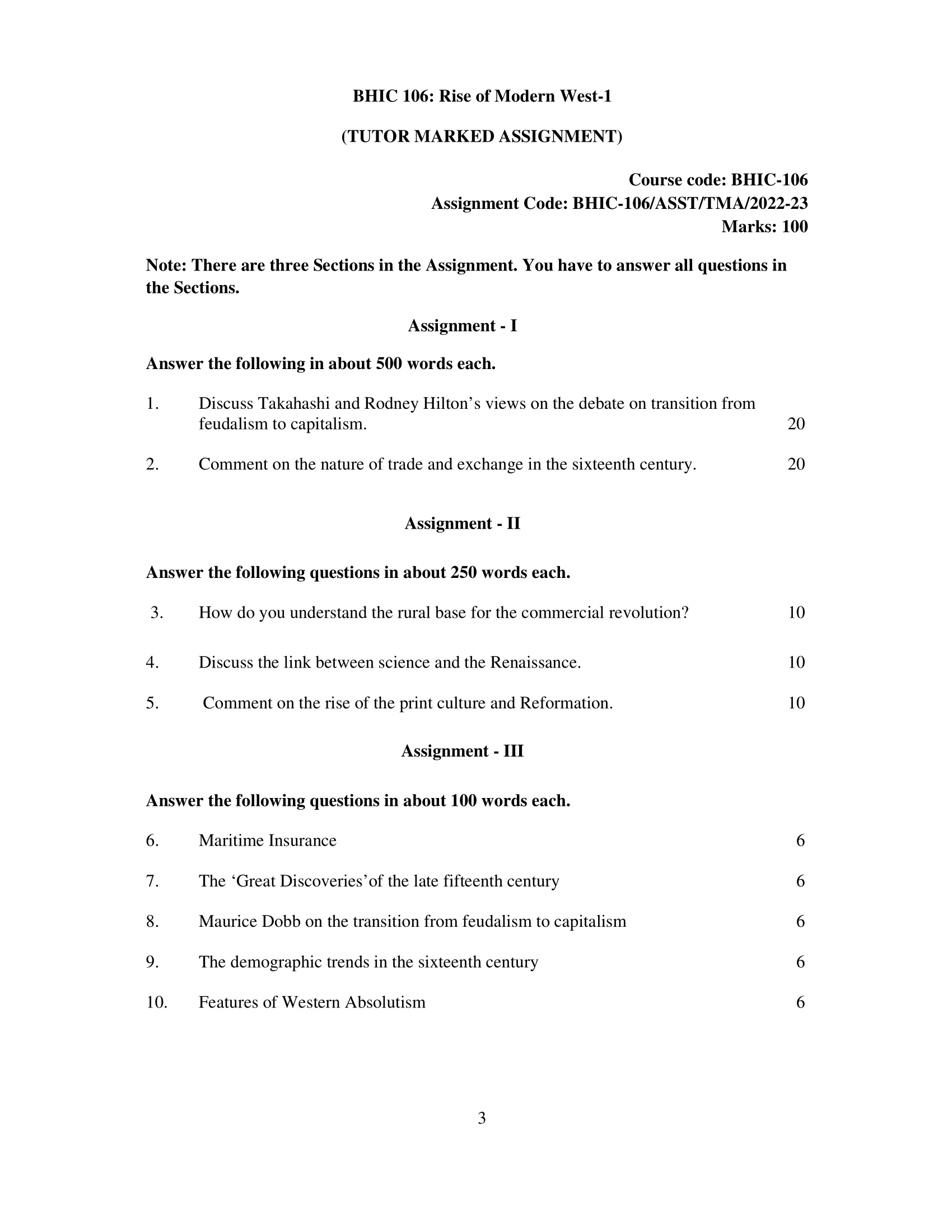Contents
- 1 Assignment – I
- 2 Answer the following in about 500 words each.
- 3 1. Discuss Takahashi and Rodney Hilton’s views on the debate on transition from feudalism to capitalism.
- 4 2. Comment on the nature of trade and exchange in the sixteenth century.
- 5 Assignment – II
- 6 Answer the following questions in about 250 words each.
- 7 3. How do you understand the rural base for the commercial revolution?
- 8 4. Discuss the link between science and the Renaissance.
- 9 5. Comment on the rise of the print culture and Reformation.
- 10 Assignment – III
- 11 Answer the following questions in about 100 words each.
- 12 6. Maritime Insurance.
- 13 7. The ‘Great Discoveries’of the late fifteenth century.
- 14 8. Maurice Dobb on the transition from feudalism to capitalism.
- 15 9. The demographic trends in the sixteenth century.
- 16 10. Features of Western Absolutism

| Title | BHIC-106: IGNOU BAG Solved Assignment 2022-2023 |
| University | IGNOU |
| Degree | Bachelor Degree Programme |
| Course Code | BHIC-106 |
| Course Name | Rise of Modern West-1 |
| Programme Name | Bachelor of Arts (General) |
| Programme Code | BAG |
| Total Marks | 100 |
| Year | 2022-2023 |
| Language | English |
| Assignment Code | BHIC-106/ASST/TMA/2022-23 |
| Last Date for Submission of Assignment: | For June Examination: 31st April For December Examination: 30th September |

Assignment – I
Answer the following in about 500 words each.
1. Discuss Takahashi and Rodney Hilton’s views on the debate on transition from feudalism to capitalism.
Ans: Takahashi and Rodney Hilton are both prominent historians and scholars of the medieval period, and their views on the debate surrounding the transition from feudalism to capitalism are of great significance in the historical community. While both historians share the belief that feudalism was a central feature of medieval society, they differ in their interpretation of the nature of this transition and its causes.
Takahashi, a Japanese historian, emphasizes the role of the peasantry in the transition from feudalism to capitalism. He argues that the growth of a market economy and the emergence of a capitalist mode of production were primarily driven by the actions of the peasantry, who, through their own economic activities, created new social relationships and economic structures. For Takahashi, the transition from feudalism to capitalism was a slow, gradual process that was initiated by the growth of the market and the increasing importance of commerce in the lives of the peasantry.
In contrast, Rodney Hilton, an English historian, places greater emphasis on the role of the nobility and the state in the transition from feudalism to capitalism. Hilton argues that the feudal lords played a crucial role in creating the conditions necessary for the development of capitalism by forcing their tenants to participate in the market economy and by promoting the growth of commercial agriculture. Hilton also argues that the state played a crucial role in this process by creating a favorable legal and institutional framework for the growth of capitalism, including the protection of property rights, the regulation of trade, and the promotion of economic growth.
Both Takahashi and Hilton provide compelling arguments for their positions on the transition from feudalism to capitalism, and both historians have had a significant impact on our understanding of this critical period in history. While Takahashi’s emphasis on the role of the peasantry in the transition has been widely accepted, Hilton’s focus on the role of the nobility and the state has also received widespread recognition.
2. Comment on the nature of trade and exchange in the sixteenth century.
Ans: The sixteenth century was a time of great change in the world of trade and exchange. This was a period of rapid expansion of commerce, as well as a time of great technological, cultural, and economic innovation. During this period, the nature of trade and exchange was transformed in a number of ways, shaping the economic and political landscape of Europe and the world.
One of the key changes in the nature of trade and exchange in the sixteenth century was the growth of long-distance trade. With the discovery of the Americas and the expansion of European exploration and trade networks, the volume of goods being traded across long distances increased dramatically. This was facilitated by the development of new technologies such as the caravel and the astrolabe, which allowed for more efficient and reliable navigation over long distances.
Another important development was the rise of commercial capitalism. The sixteenth century saw the emergence of a new class of merchants who were engaged in large-scale trade and investment. These merchants played a crucial role in financing the expansion of trade and commerce, as well as in shaping the economic and political institutions of the time. This new merchant class also contributed to the growth of cities, which became important centers of trade, commerce, and culture.
The growth of trade and commerce also led to the rise of the monetary economy. The sixteenth century saw the widespread adoption of a single currency, the gold-based monetary system, which facilitated trade and made it easier for merchants to conduct business across long distances. This also contributed to the growth of a new financial sector, as merchants began to use credit and loans to finance their activities.
In addition, the sixteenth century saw the development of a new system of production and distribution. This was driven by the growth of manufacture, which involved the mass production of goods in workshops and factories, as well as the development of a new system of distribution that made use of the emerging transportation and communication networks. This system of production and distribution allowed for the growth of the market economy, which played a critical role in shaping the economic and political landscape of Europe and the world.
Assignment – II
Answer the following questions in about 250 words each.
3. How do you understand the rural base for the commercial revolution?
Ans: The rural base for the commercial revolution refers to the changes that took place in rural society and the economy during the period of significant commercial expansion from the 16th to the 18th centuries. This was a time when trade and commerce, including the production and exchange of goods, were undergoing significant growth, both domestically and internationally. This growth was driven by a number of factors, including the expansion of markets, the development of new technologies and transportation networks, and the growth of financial institutions.
One of the most significant changes in rural society during this period was the transformation of agrarian economies into market-oriented economies. This shift was driven by the growth of trade, which allowed farmers to sell their surplus crops and livestock, and also by the growth of urban markets, which created new opportunities for rural producers. At the same time, advances in agriculture, including the widespread adoption of new crops, such as potatoes and corn, and the development of new techniques for crop rotation and soil improvement, led to significant increases in agricultural productivity.
The commercial revolution also had a profound impact on rural society, as the growth of trade and commerce created new opportunities for employment, particularly in crafts, trade, and transportation. Many rural workers, particularly in Europe, became involved in the production of textiles, leather goods, and other manufactured goods, and also in the transport and trade of goods, both domestically and internationally.
Overall, the rural base for the commercial revolution played a critical role in the development of modern capitalism, as the growth of trade, commerce, and industry created new opportunities for rural workers, and laid the foundation for the growth of urban centers, and the development of new economic institutions, such as banks and stock markets. This, in turn, laid the foundation for the industrial revolution, which would further transform rural society and the economy, and lead to significant advances in technology, science, and medicine, and ultimately, to the modern world as we know it today.
4. Discuss the link between science and the Renaissance.
Ans: The Renaissance, which took place from the 14th to the 17th centuries, was a period of great cultural, artistic, and intellectual revival in Europe. During this time, there was a revival of classical learning and a renewed interest in science, which was closely linked to the Renaissance movement. This connection between science and the Renaissance is often referred to as the Scientific Revolution.
During the Renaissance, there was a shift in the way that people thought about science and knowledge. Instead of relying solely on the ancient texts of classical authors, scientists began to make observations and experiments, and develop new theories based on their findings. This approach was influenced by the rediscovery of classical texts, such as those of Aristotle and Ptolemy, as well as by the new mathematical and astronomical discoveries made during the Renaissance.
One of the most significant figures of the Scientific Revolution was Galileo Galilei, who made major contributions to the fields of physics, astronomy, and mathematics. He was the first to use a telescope to observe the heavens, and made groundbreaking discoveries about the motion of celestial bodies. Another important figure was Nicolaus Copernicus, who proposed the idea that the earth and other planets revolve around the sun, and developed a heliocentric model of the universe.
The Scientific Revolution also had a profound impact on philosophy, as scientists began to challenge traditional beliefs and assumptions about the natural world. This questioning of authority, combined with the growth of experimental methods and mathematical models, led to a new understanding of the universe and the development of modern science.
5. Comment on the rise of the print culture and Reformation.
Ans: The rise of print culture and the Reformation were two major developments in Europe during the late medieval and early modern periods. They were both closely linked, and had a profound impact on the religious, cultural, and political landscape of Europe.
The rise of print culture was a major factor in the spread of the Reformation. The invention of the printing press in the 15th century made it possible to produce books and pamphlets on a large scale, which allowed for the rapid dissemination of new ideas and religious texts. This was particularly significant for the Reformation, as it enabled the reformers to reach a wide audience with their teachings and to spread their ideas quickly and efficiently. The production of the Bible in vernacular languages, such as German and English, was also a key aspect of the rise of print culture and the Reformation, as it allowed people to read and interpret the scriptures for themselves, rather than relying solely on the interpretations of the clergy.
The Reformation, in turn, had a profound impact on print culture. The demand for religious books and pamphlets increased significantly, as people sought to learn more about the teachings of the reformers, and the debates and controversies that surrounded the Reformation fueled the production of even more books and pamphlets. The rise of print culture thus played a crucial role in the spread of the Reformation, and in the transformation of religious, cultural, and political life in Europe.
Assignment – III
Answer the following questions in about 100 words each.
6. Maritime Insurance.
Ans: Maritime insurance is a type of insurance that covers ships, cargo, and other related risks during the course of maritime transportation. It protects against loss or damage to the ship, cargo, and other associated risks such as piracy, hijacking, and natural disasters. The coverage can be customized based on the type of ship, the nature of the cargo, and the route of the voyage.
Maritime insurance is typically provided by specialized insurance companies, and is an essential component of international trade and commerce. It helps to mitigate the risks associated with maritime transportation and to ensure that shipping companies and their customers can operate with confidence and security. The premiums for maritime insurance are based on the perceived risks involved in the voyage, and are an important cost factor for shipping companies and their customers.
7. The ‘Great Discoveries’of the late fifteenth century.
Ans: The “Great Discoveries” of the late 15th century were a series of voyages of exploration made by European navigators and sailors that greatly expanded European knowledge of the world. The most notable of these discoveries were the voyages of Christopher Columbus, who discovered the New World in 1492, and Vasco da Gama, who discovered the sea route to India in 1498.
These discoveries had far-reaching consequences for Europe, and led to the establishment of colonies and trading posts in the Americas, Africa, and Asia. They also helped to spur the development of new trade routes and commercial networks, which had a profound impact on the economy and society of Europe. In addition, the discovery of new lands and peoples expanded European knowledge of the world, and helped to stimulate further exploration and discovery.
The Great Discoveries also had a significant impact on science, as the new discoveries helped to spark a renewed interest in geography, cartography, and navigation, and led to the development of new instruments and methods for mapping the world. The voyages of exploration also helped to spread new ideas and technologies across the world, and laid the foundation for the age of exploration and global expansion that followed.
8. Maurice Dobb on the transition from feudalism to capitalism.
Ans: Maurice Dobb was a British economist and historian who wrote extensively on the transition from feudalism to capitalism. He argued that this transition was not a simple or straightforward process, but was instead characterized by a number of complex and interconnected economic, social, and political changes.
According to Dobb, the feudal system was based on a system of obligations and duties, in which lords and serfs were bound together in a reciprocal relationship. Over time, however, this relationship changed, as lords began to shift their focus from land-based production to commerce and trade. This change was driven by a number of factors, including the growth of urban areas, the expansion of trade, and the increased availability of money.
Dobb also argued that the transition from feudalism to capitalism was not a simple, linear process, but was instead shaped by a number of different factors, including the impact of the Black Death, the growth of towns and cities, and the rise of the merchant class. He also emphasized the role of the state in the transition, arguing that the state played a key role in shaping the economic, social, and political landscape of Europe during this period.
9. The demographic trends in the sixteenth century.
Ans: The sixteenth century was a time of significant demographic change in Europe. Some of the key trends included:
- Population growth: The population of Europe grew significantly during the sixteenth century, reaching approximately 100 million by 1600. This was due in part to improved agricultural practices, as well as to advancements in medicine and public health.
- Urbanization: The sixteenth century saw the growth of cities and urban areas, as people moved from rural areas in search of work and opportunity. This led to the growth of a new urban culture, characterized by a concentration of wealth, commerce, and cultural life.
- Migration: The sixteenth century saw significant migration, as people moved within and between countries in search of work, land, and religious freedom. This was particularly true in the wake of the Protestant Reformation, which led to religious conflict and persecution in many parts of Europe.
- Life expectancy: Life expectancy in Europe increased during the sixteenth century, as advances in medicine and public health reduced the incidence of disease and improved overall health.
- Birth and death rates: The birth and death rates in Europe changed significantly during the sixteenth century, with the birth rate increasing and the death rate declining. This contributed to the overall growth of the population.
10. Features of Western Absolutism
Ans: Western Absolutism was a political and social system that emerged in Europe during the seventeenth and eighteenth centuries. It was characterized by several key features, including:
- Centralized power: Western Absolutism was characterized by the concentration of power in the hands of the monarch, who was considered to be the ultimate authority in the state.
- Divine Right of Kings: The monarchs claimed that they held their power by divine right and that their authority was sanctioned by God.
- Bureaucratic control: The state was administered by a centralized bureaucracy that was responsible for carrying out the policies of the monarch.
- Limited constitutionalism: Western Absolutism was often accompanied by limited constitutionalism, in which the monarch agreed to be bound by certain laws and institutions, but retained the ultimate power to make decisions and enforce policies.
- Economic policies: Western Absolutism was characterized by a focus on economic growth and development, with the monarchs often taking an active role in promoting trade and commerce.
Overall, Western Absolutism was a political and social system that emphasized the power and authority of the monarch, as well as the importance of economic growth and development. While it was often associated with political stability and economic prosperity, it also led to criticism and opposition from those who saw it as a threat to individual liberty and freedom.
How to Download BHIC-106 Solved Assignment?
You can download it from the www.edukar.in, they have a big database for all the IGNOU solved assignments.
Is the BHIC-106 Solved Assignment Free?
Yes this is absolutely free to download the solved assignment from www.edukar.in
What is the last submission date for BHIC-106 Solved Assignment?
For June Examination: 31st April, For December Examination: 30th October















